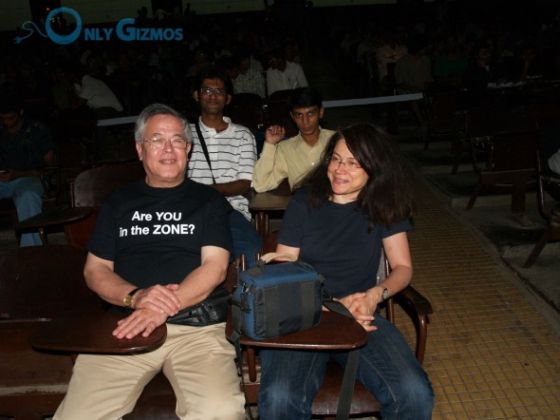 Mr Vic Hayes at IIT Techfest (also pictured Dr Alessandra)
Mr Vic Hayes at IIT Techfest (also pictured Dr Alessandra)
Special thanks to Aditya Sengupta [@sengupta (Blog)] for the interview on behalf of OnlyGizmos
Before attending Lars Rasmussen’s lecture, we attended what turned out to be one of the more technical lectures at Techfest 2010. The ‘Father of Wi-Fi’, Mr. Vic Hayes is a very unassuming man, going so far as to insist that the organizers call him Mister instead of Doctor as was mentioned on the official schedule and posters. We caught up with him before his lecture and asked him a couple of questions. (Video below)
He explained how the motivation for WiFi- known then simply as IEEE 802.11- a wireless technical standard- was to enable cash registers to be placed anywhere in retail stores without having to lug wires around each time the floor plan was changed. 802.11 was made possible when the FCC approved spectrum for general use without requiring end user licenses (compare that to the brouhaha over the 3G spectrum licenses). The ubiquitous 2.45GHz frequency radio band- which is used in devices ranging from cordless phones to microwave ovens soon came to connect people across the world in what we are more familiar as WiFi.
He talked about the challenges he faced convincing companies to get on the same page- particularly in an environment where every manufacturer wanted to push its own standards. He then explained the need for the “WiFi” trademark as something distinct from the IEEE 802.11 standard- with a rare jab of humour at how the first press release for WiFi was relegated to the trashcan by editors because it was written by engineers and thus had far too many technicalities.
We also ask him whether wires are still relevant in today’s day and age, and why- particularly with the release of the latest iteration of the 802.11 standard- 11n which delivers data 10 times faster than today’s WiFi.
He ends with his thoughts on regulatory issues with long range WiFi and what he wished he could have changed about his approach to WiFi if he could go back. He elaborates on the user led innovation around long range WiFi during the lecture by giving an example of how Magsaysay Laureate, Mahabir Pun, who, fed up by the fact that he could not arrange for a telephone line for an internet connection, set up a set of long range wireless relay stations that connected 42 villages perched on mountains to the internet using donated communication equipment and computers over 5 years.



